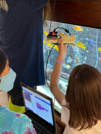
Conditional Remix & Share Permitted
CC BY-NC-SA
Students are practicing using Scratch programming to program microbit sensors to continually read temperature. Doing this will familiarize students with the Scratch programming software to program TDS and Temperature sensors for the fishtank in the hallway.
- Subject:
- Computer Science
- Science
- Material Type:
- Lesson Plan
- Author:
- Kim Wilkens
- Date Added:
- 07/24/2022